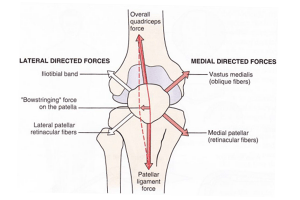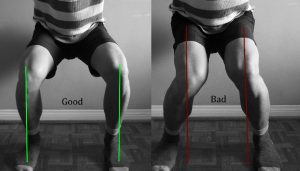There is a delicate game of tug-o-war happening in your knee right now, and if the teams are tied, you’ll be feeling pretty good. If not, pain on the front or medial part of the knee or kneecap can be a problem across all age groups, from children to the elderly.
To bend and straighten properly, your kneecap must slide perfectly along its groove. If it is not tracking properly, then you might get pain with stairs, running, jumping, or even just walking or standing after you’ve been sitting. This picture shows some of the muscles that need to stay in balance…
 Most tracking issues happen when the knee cap gets pulled toward the outside. Commonly the outer muscles are too tight (ex. IT Band and Hip Flexors), and the inner muscles aren’t strong enough (Inner Quadriceps).
Often, these knee problems don’t even start from the knee itself and originate with imbalances in the ankles and/or hips.
Most tracking issues happen when the knee cap gets pulled toward the outside. Commonly the outer muscles are too tight (ex. IT Band and Hip Flexors), and the inner muscles aren’t strong enough (Inner Quadriceps).
Often, these knee problems don’t even start from the knee itself and originate with imbalances in the ankles and/or hips.
 Most tracking issues happen when the knee cap gets pulled toward the outside. Commonly the outer muscles are too tight (ex. IT Band and Hip Flexors), and the inner muscles aren’t strong enough (Inner Quadriceps).
Often, these knee problems don’t even start from the knee itself and originate with imbalances in the ankles and/or hips.
Most tracking issues happen when the knee cap gets pulled toward the outside. Commonly the outer muscles are too tight (ex. IT Band and Hip Flexors), and the inner muscles aren’t strong enough (Inner Quadriceps).
Often, these knee problems don’t even start from the knee itself and originate with imbalances in the ankles and/or hips.
- Stiff ankles or over-pronating feet will cause the knee to cave in slightly with activity
- Relatively weak hips will not be able to keep the knees aligned over the feet
All of this leads to improper tracking of the knee cap!
Try doing a squat in front of the mirror. What does it look like?
Too easy? What about on one leg? It happens to some degree with every step.
HOW DO YOU FIX IT??
Complete recovery will require 4 stages:
1 – Identify and eliminate (or greatly reduce) the aggravating activity! To give your knee a chance to heal properly. Ice can help in this stage if there is some inflammation.
2 – Stretch and foam roll (the tight parts)! This will be your calves, hip flexors, IT Band, quadriceps, and sometimes hamstrings.
3 – Strengthen (when not painful to do so)! This will be your glutes (side and back of the hips), inner quads, and sometimes your feet and core. Start light and gradually increase the intensity.
4 – Gradually return to your activities with your new knowledge and balanced movements.
This can be a complicated problem, so we recommend letting a physiotherapist help guide you through the process and provide additional treatment that is often required to get from one stage to the next (this may involve manual therapy, soft tissue techniques, taping, or acupuncture). We always tailor the exercises to each individual to make sure they are effective and pain-free.
Rob McMillan – Registered Physiotherapist Services Offered:
Acupuncture
Dry Needling
Intramuscular Stimulation (IMS)
Physiotherapy
Virtual Physiotherapy







